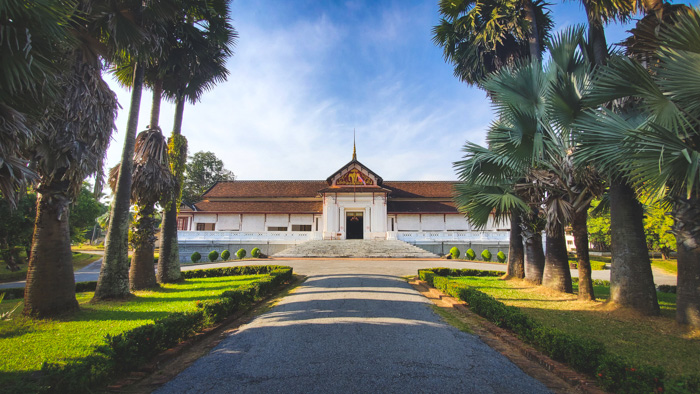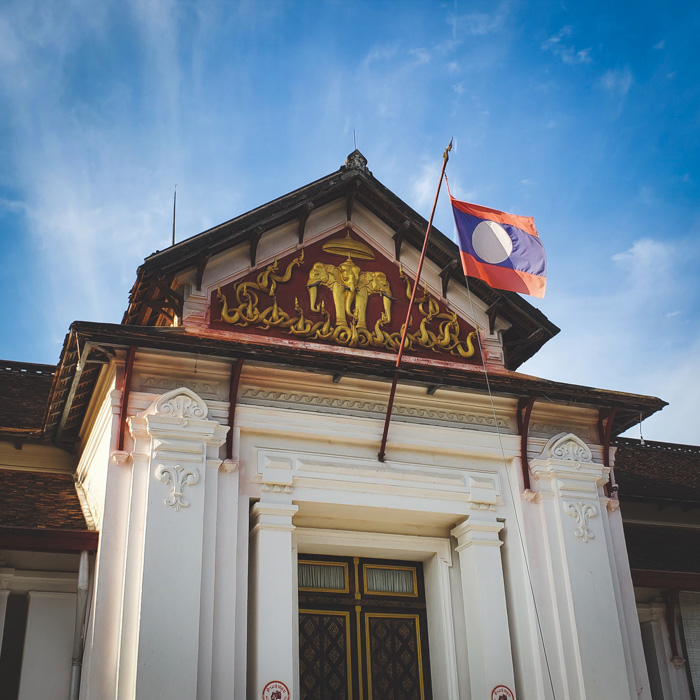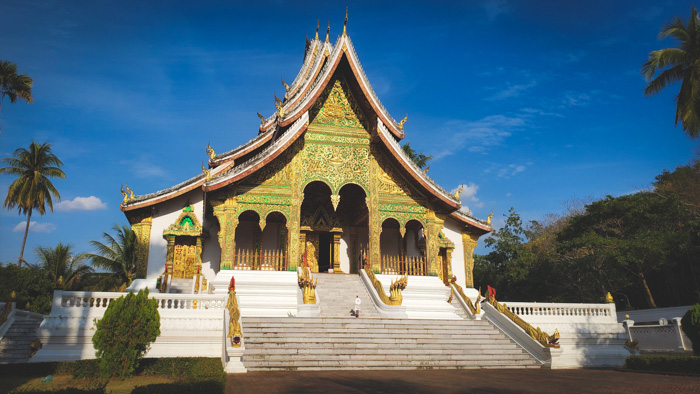National Museum
National Museum of Luang Prabang (Former Royal Palace of Luang Prabang)

The National Museum of Luang Prabang, or the former Royal Palace, covers an area of 37,000 square meters, which was built in 1904 and completed in 1909 during the reign of King Sisavang Vong. The building was designed by a French architect named in Lao as Thone. It features a blend of Lao traditional and French style. Most of the materials used in the construction were from the local area. The French government built this place as a gift to the King of Lao Kingdom of Lane Xang during the reign of King Sisavang Vong as the residence of the Lao Royal Family. By the year 1930, the central spire was modified to be a Lao cultural art of Luang Prabang.
The highlights of the building are the pediment and the central spire. The pediment is adorned with a three-headed elephant under a white parasol and the 15 tribes of Naga (a three-headed elephant is an elephant of the Pha In deity used as a transport going down to the human world). For the 15 tribes of Naga, it is said that Pha Rassi and his brother built a city in Phou Suang, also known as Phou Si now, and Pha Rassi named this city as Muang Xieng Dong Xieng Thong Sisatthanark (Muang Xua). After the city was completely built and named, the two brothers sat together at the estuary of Khan River under the golden tree and then Pha Rassi called for all Naga to reunite.
The Lao Kingdom of Luang Prabang Lane Xang Hom consisted of 63 kings. The first monarch was Khun Lo Rasathirath; Phaya Chao Fa Ngum was the 23rd monarch; and King Sisavang Vattana was the last monarch. From 1960 to 1975, there was no coronation ceremony because the political situation in the Lao Kingdom at that time was not peaceful, which was during the colonial era of United States of America. The palace was resided by two kings: King Sisavang Vong from 1905 to 1959 and King Sisavang Vattana from 1959 to 1975. After King Sisavang Vong died in 1959, King Sisavang Vattana, one of his sons, continued to ascend the Lao Kingdom Lane Xang Hom Khao as followed the royal tradition until 1975.

After the country was established as the Lao People's Democratic Republic on December 2, 1975, King Sisavang Vattana abdicated and handed over the palace to the Lao government. The government then improved and changed the palace into a national museum from March 13, 1976 to the present.
Ho Pha Bang

Ho Pha Bang (an ornate pavilion) was established in 1969 during the reign of King Sisavang Vattana, designed by Manivong Khattiyarath, a master craftsman of Luang Prabang with a unique and original Lao traditional structure. However, the construction of Ho Pha Pang at that time was not completed and only a few foundations and pillars were completed. The construction was then restored when the palace changed into this National Museum of Luang Prabang.
Pha Bang is a sacred statue of the Buddha for Laos as a whole and in particular for Luang Prabang. It is a standing statue with both hands raised in the attitude of Abhayamudra as in the Dispelling Fear position, made of precious metal alloys like gold, silver and copper alloys, with a height of 83 cm and a weight of 53.34 kg. According to a record of the ancient chronicle, Pha Bang made in Sri Lanka. In the 1st century, after the Lord Buddha ascended to Nibbāna for 436 months, a great Buddhist saint named Choulanakhathera in Sri Lanka presided over the casting of this Buddha statue. He then invited the Lord Buddha to be placed in the Pha Bang statue on five parts: (1) in the forehead, (2) in the chin, (3) in the chest, (4) in the left palm, and (5) in the right palm. After 1,400 months, by the year 1500 there was a man named Phaya Soubinnarath occupied the throne in Lanka Thavib and his friend named Pha Chao Siri Chantharath of Inthapattha capital city in Cambodia. After Phaya Siri Chantharath heard about Pha Bang, a sacred Buddha image worshiped by everyone, he also wanted to invite Pha Bang to be enshrined in the capital city. Accordingly, Phaya Soupinnarath were happy to give Pha Bang to the Counselor to the King of Inthapattha capital city in Cambodia (Pha Bang was invited from Sri Lanka to be enshrined in Cambodia in 654 BE or 111 CE). Phaya Siri Chantharath, mayor of Inthapattha capital city, welcomed Pha Bang to be enshrined in the central chapel of the capital city. Since then, Pha Bang was enshrined in Inthapattha capital city worshiped by Phaya Siri Chantharath and all people.
The ceremony of inviting Pha Bang to be placed in Wat Mai Souvanna Phoummaram
During the Lao New Year Festival in the 5th Lunar Month every year, the people of Luang Prabang hold a ceremony of inviting Pha Bang from the National Museum of Luang Prabang to be placed in Wat Mai Souvanna Phoummaram for all Buddhists to worship according to the tradition. Both domestic and foreign people could poor water on Pha Bang with a traditional ceremony for three days and nights. After that, Pha Bang would be invited back through the religious ceremony to be enshrined in the National Museum of Luang Prabang, which would be the end of ceremony.
The procession ceremony of Pha Bang includes:
(1) The authority opens the way; (2) the young people hold the national flags and the religious flags; (3) the procession of traditional music; (4) the procession of the eight Brahmins; (5) the procession of blowing conches and ringing bells; (6) the procession of monks; (7) the procession of dressing Phatio (a piece of cloth which is wrapped around the hips, passed between legs and tied at the waist) with carrying traditional bowl (bowl of silver or gold) containing flowers; (8) Pha Bang Carriage; (9) the seven Phathenouthera; (10) the elders; (11) the procession of leaders’ wives, all people along with the medias; (12) the young people wearing the white clothes with holding candles (six people on each side next to novices); (13) the young people wearing red clothes with playing drums or gongs (next to the leaders wearing Phatio, and six people on each side of Pha Bang Carriage).
Background of the Theatre
The story of Ramayana has been brought to the land of Lane Xang by Phoutthamamaka for centuries. The summary of the story is that Phalak Phalam (representative of justice) pursued the rescue of Nang Sida, who was abducted by a giant Thotsakan (representative of Atham - injustice) of Lanka city in Sri Lanka.
This story was performed to the people of all ethnic groups on the occasion of important festivals, especially the Lao New Year festival of every year. When the city faced difficult times, this story was stopped playing for a while. Due to the fact that the play of Phalak Phalam story was produced and edited by the working class people, the party and government have then remade in order to teach the young people for continuing the performance of this story. From 1993 onwards, this performance has been showed to the public, domestic and foreign tourists.
In addition, the theater has received supports from individuals, legal entities, and social organizations, such as from the Party-State leaders, the Office of the French-speaking countries in Lao PDR in 2000, the Ethnic Institute of the Federal Republic of Germany in 2001, funds from the Singapore Theatre from 2002 to 2003 and Social Development Fund of the French Embassy in Laos from 2011 to 2013.
